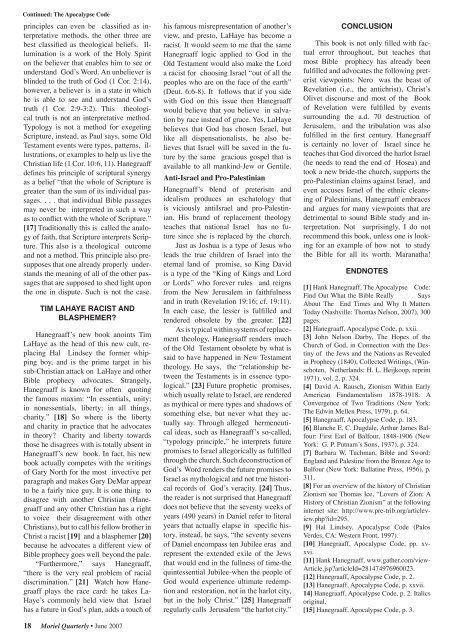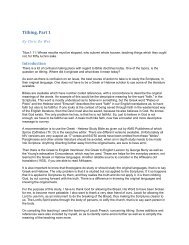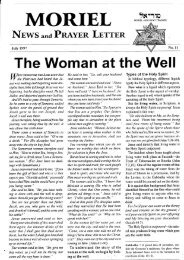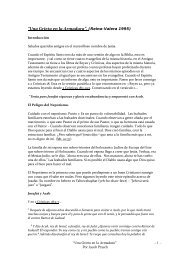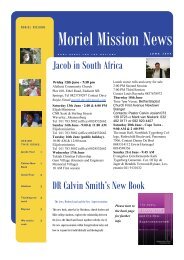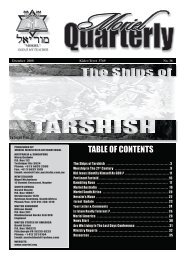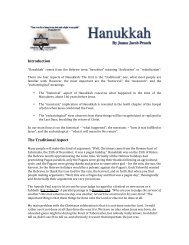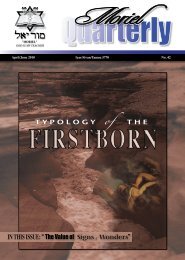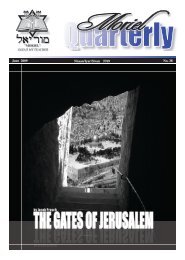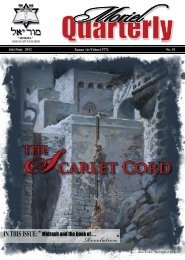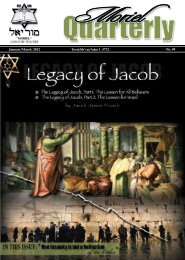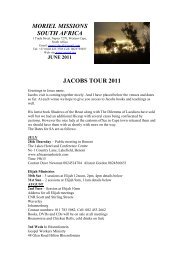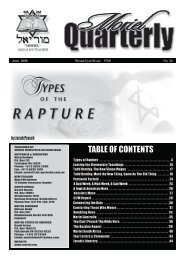Spiritual Warfare and Territorial Spirits (~5.5 MB) - Moriel Ministries
Spiritual Warfare and Territorial Spirits (~5.5 MB) - Moriel Ministries
Spiritual Warfare and Territorial Spirits (~5.5 MB) - Moriel Ministries
You also want an ePaper? Increase the reach of your titles
YUMPU automatically turns print PDFs into web optimized ePapers that Google loves.
Continued: The Apocalypse Codeprinciples can even be classified as interpretativemethods, the other three arebest classified as theological beliefs. Illuminationis a work of the Holy Spiriton the believer that enables him to see orunderst<strong>and</strong> God’s Word. An unbeliever isblinded to the truth of God (1 Cor. 2:14),however, a believer is in a state in whichhe is able to see <strong>and</strong> underst<strong>and</strong> God’struth (1 Cor. 2:9-3:2). This theologicaltruth is not an interpretative method.Typology is not a method for exegetingScripture, instead, as Paul says, some OldTestament events were types, patterns, illustrations,or examples to help us live theChristian life (1 Cor. 10:6, 11). Hanegraaffdefines his principle of scriptural synergyas a belief “that the whole of Scripture isgreater than the sum of its individual passages.. . . that individual Bible passagesmay never be interpreted in such a wayas to conflict with the whole of Scripture.”[17] Traditionally this is called the analogyof faith, that Scripture interprets Scripture.This also is a theological outcome<strong>and</strong> not a method. This principle also presupposesthat one already properly underst<strong>and</strong>sthe meaning of all of the other passagesthat are supposed to shed light uponthe one in dispute. Such is not the case.Tim LaHaye Racist <strong>and</strong>Blasphemer?Hanegraaff’s new book anoints TimLaHaye as the head of this new cult, replacingHal Lindsey the former whippingboy, <strong>and</strong> is the prime target in hissub-Christian attack on LaHaye <strong>and</strong> otherBible prophecy advocates. Strangely,Hanegraaff is known for often quotingthe famous maxim: “In essentials, unity;in nonessentials, liberty; in all things,charity.” [18] So where is the liberty<strong>and</strong> charity in practice that he advocatesin theory? Charity <strong>and</strong> liberty towardsthose he disagrees with is totally absent inHanegraaff’s new book. In fact, his newbook actually competes with the writingsof Gary North for the most invective perparagraph <strong>and</strong> makes Gary DeMar appearto be a fairly nice guy. It is one thing todisagree with another Christian (Hanegraaff<strong>and</strong> any other Christian has a rightto voice their disagreement with otherChristians), but to call his fellow brother inChrist a racist [19] <strong>and</strong> a blasphemer [20]because he advocates a different view ofBible prophecy goes well beyond the pale.“Furthermore,” says Hanegraaff,“there is the very real problem of racialdiscrimination.” [21] Watch how Hanegraaffplays the race card: he takes La-Haye’s commonly held view that Israelhas a future in God’s plan, adds a touch of18 <strong>Moriel</strong> Quarterly • June 2007his famous misrepresentation of another’sview, <strong>and</strong> presto, LaHaye has become aracist. It would seem to me that the sameHanegraaff logic applied to God in theOld Testament would also make the Lorda racist for choosing Israel “out of all thepeoples who are on the face of the earth”(Deut. 6:6-8). It follows that if you sidewith God on this issue then Hanegraaffwould believe that you believe in salvationby race instead of grace. Yes, LaHayebelieves that God has chosen Israel, butlike all dispensationalists, he also believesthat Israel will be saved in the futureby the same gracious gospel that isavailable to all mankind-Jew or Gentile.Anti-Israel <strong>and</strong> Pro-PalestinianHanegraaff’s blend of preterism <strong>and</strong>idealism produces an eschatology thatis viciously antiIsrael <strong>and</strong> pro-Palestinian.His br<strong>and</strong> of replacement theologyteaches that national Israel has no futuresince she is replaced by the church.Just as Joshua is a type of Jesus wholeads the true children of Israel into theeternal l<strong>and</strong> of promise, so King Davidis a type of the “King of Kings <strong>and</strong> Lordor Lords” who forever rules <strong>and</strong> reignsfrom the New Jerusalem in faithfulness<strong>and</strong> in truth (Revelation 19:16; cf. 19:11).In each case, the lesser is fulfilled <strong>and</strong>rendered obsolete by the greater. [22]As is typical within systems of replacementtheology, Hanegraaff renders muchof the Old Testament obsolete by what issaid to have happened in New Testamenttheology. He says, the “relationship betweenthe Testaments is in essence typological.”[23] Future prophetic promises,which usually relate to Israel, are renderedas mythical or mere types <strong>and</strong> shadows ofsomething else, but never what they actuallysay. Through alleged hermeneuticalideas, such as Hanegraaff’s so-called,“typology principle,” he interprets futurepromises to Israel allegorically as fulfilledthrough the church. Such deconstruction ofGod’s Word renders the future promises toIsrael as mythological <strong>and</strong> not true historicalrecords of God’s veracity. [24] Thus,the reader is not surprised that Hanegraaffdoes not believe that the seventy weeks ofyears (490 years) in Daniel refer to literalyears that actually elapse in specific history,instead, he says, “the seventy sevensof Daniel encompass ten Jubilee eras <strong>and</strong>represent the extended exile of the Jewsthat would end in the fullness of time-thequintessential Jubilee-when the people ofGod would experience ultimate redemption<strong>and</strong> restoration, not in the harlot city,but in the holy Christ.” [25] Hanegraaffregularly calls Jerusalem “the harlot city.”ConclusionThis book is not only filled with factualerror throughout, but teaches thatmost Bible prophecy has already beenfulfilled <strong>and</strong> advocates the following preteristviewpoints: Nero was the beast ofRevelation (i.e., the antichrist), Christ’sOlivet discourse <strong>and</strong> most of the Bookof Revelation were fulfilled by eventssurrounding the a.d. 70 destruction ofJerusalem, <strong>and</strong> the tribulation was alsofulfilled in the first century. Hanegraaffis certainly no lover of Israel since heteaches that God divorced the harlot Israel(he needs to read the end of Hosea) <strong>and</strong>took a new bride-the church, supports thepro-Palestinian claims against Israel, <strong>and</strong>even accuses Israel of the ethnic cleansingof Palestinians. Hanegraaff embraces<strong>and</strong> argues for many viewpoints that aredetrimental to sound Bible study <strong>and</strong> interpretation.Not surprisingly, I do notrecommend this book, unless one is lookingfor an example of how not to studythe Bible for all its worth. Maranatha!Endnotes[1] Hank Hanegraaff, The Apocalypse Code:Find Out What the Bible Really SaysAbout The End Times <strong>and</strong> Why It MattersToday (Nashville: Thomas Nelson, 2007), 300pages.[2] Hanegraaff, Apocalypse Code, p. xxii.[3] John Nelson Darby, The Hopes of theChurch of God, in Connection with the Destinyof the Jews <strong>and</strong> the Nations as Revealedin Prophecy (1840), Collected Writings, (Winschoten,Netherl<strong>and</strong>s: H. L. Heijkoop, reprint1971), vol. 2, p. 324.[4] David A. Rausch, Zionism Within EarlyAmerican Fundamentalism 1878-1918: AConvergence of Two Traditions (New York:The Edwin Mellen Press, 1979), p. 64.[5] Hanegraaff, Apocalypse Code, p. 183.[6] Blanche E. C. Dugdale, Arthur James Balfour:First Earl of Balfour, 1848-1906 (NewYork: G. P. Putnam’s Sons, 1937), p. 324.[7] Barbara W. Tuchman, Bible <strong>and</strong> Sword:Engl<strong>and</strong> <strong>and</strong> Palestine from the Bronze Age toBalfour (New York: Ballatine Press, 1956), p.311.[8] For an overview of the history of ChristianZionism see Thomas Ice, “Lovers of Zion: AHistory of Christian Zionism” at the followinginternet site: http://www.pre-trib.org/articleview.php?id=295.[9] Hal Lindsey, Apocalypse Code (PalosVerdes, CA: Western Front, 1997).[10] Hanegraaff, Apocalypse Code, pp. xvxvi.[11] Hank Hanegraaff, www.gather.com/view-Article.jsp?articleId=281474976960023.[12] Hanegraaff, Apocalypse Code, p. 2.[13] Hanegraaff, Apocalypse Code, p. xxvii.14] Hanegraaff, Apocalypse Code, p. 2. Italicsoriginal.[15] Hanegraaff, Apocalypse Code, p. 3.


